Visiting Portugal is lovely for many reasons. But the delicious Portuguese cuisine? That is number one. While Portuguese cuisine is known for its tasty seafood dishes, you’ll find many different Portuguese foods that are based on local traditions and recipes.
You could be biting into a Portuguese tart, sitting down for some classic Piri Piri chicken, or sipping a tiny glass of port. The best thing is that many of these dishes are easy to replicate at home – meaning you don’t even have to catch a flight.
Table of Contents
Traditional Portuguese Food
Excited to try some traditional Portuguese foods? You should be. Portuguese recipes burst with flavor – whether coated in a spicy sauce or drizzled with lemon juice. These are the ten best Portuguese dishes for you to try.
1. Pastel de Nata
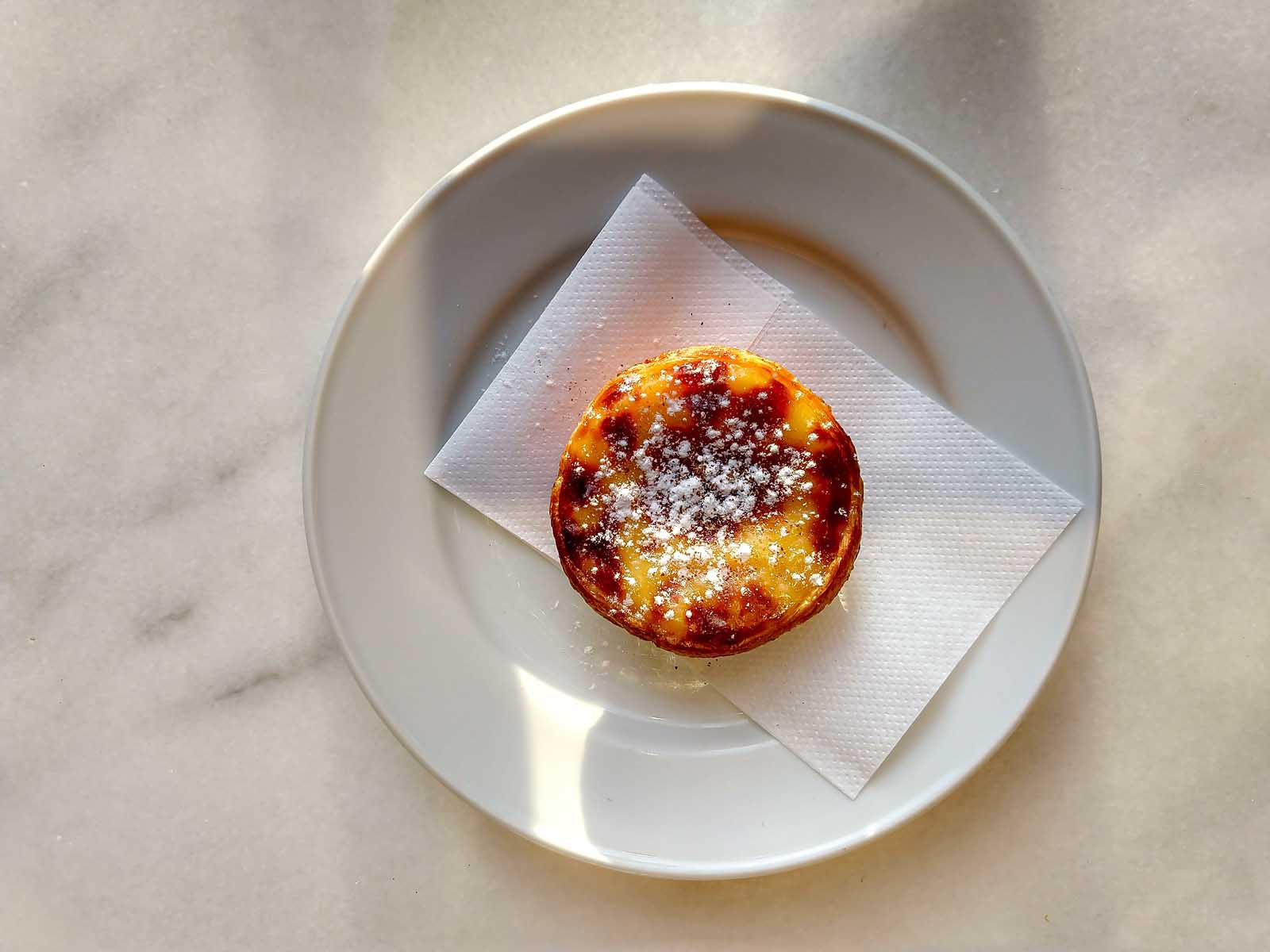
Pastel de nata is a Portuguese dessert and one of our favorite Portuguese dishes. The crispy pastry is filled with soft egg custard, typically sprinkled with cinnamon and powdered sugar – much like a creme brulee. Pastel de nata is served bite-sized and is best enjoyed fresh and still slightly hot from the oven. If you are looking for a sweet treat, these Portuguese custard tarts are easily one of the best Portuguese desserts.
So, where did such a tasty dessert originate from? It is believed that we have a group of monks from Lisbon to thank. The monks in Jeronimos Monastery in the 18th century created the tarts as a means of income to support the monastery, selling the recipe when it eventually closed.
Now, Portuguese chefs all over the country make pastel de nata. Pastel de nata is sold in most bakeries, cafes, and restaurants. As far as desserts go in Portugal, pastel de nata is on its way to becoming a national dish. The pastry is the trickiest bit to perfect, and the texture is sublime – so crispy that it nearly shatters with a bite. The pastry is usually made first while the custard mixture is prepared. If you follow this recipe you will be able to make the perfect Pastel de Nata. Freshness is essential with pastel de nata, and the dish is intended to be cooked and eaten on the same day for the most authentic experience.
2. Peixe Grelhado
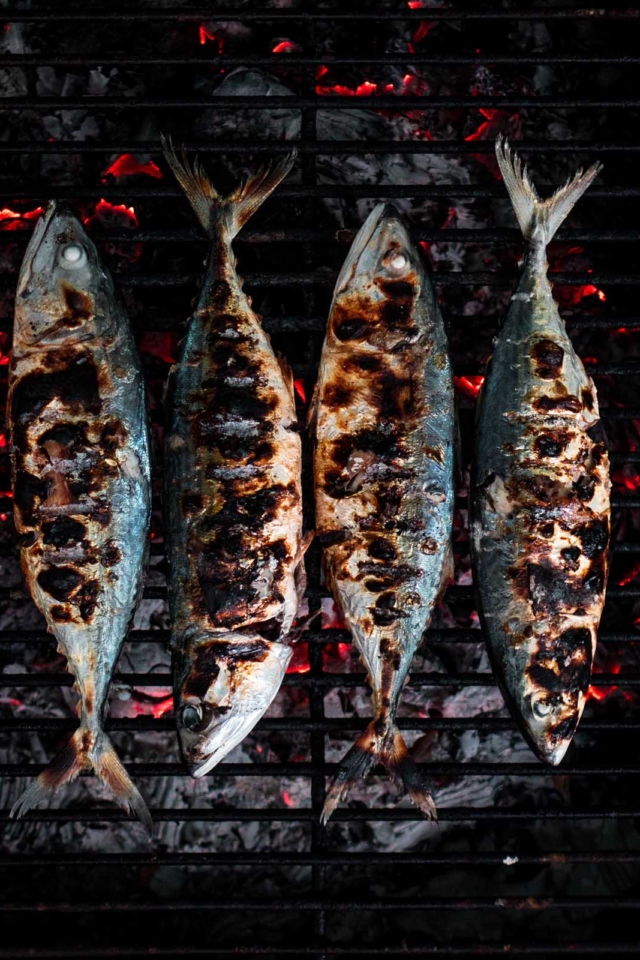
Peixe Grelhado translates as grilled fish, and the dish is served as just that. If you order this at a restaurant, you can expect an entire grilled fish served on your plate (skin and head and all). It can be a daunting experience, but as soon as you take your first bite, any skepticism or hesitancy will be alleviated. You’ll also get to taste the benefit of Portuguese olive oil since the grilled fish is served drizzled. Peixe Grelhado is proof that there is beauty in simplicity.
Peixe Grelhado is usually served alongside herby-boiled potatoes, steamed vegetables, and a light salad with vinegar. The meat is the dish’s focus since it is specially cooked on a charcoal grill.
Peixe grelhado most commonly uses fish like seabass, golden bream, and grouper. Fishing in Portugal has been around for centuries, and fishermen’s catch made up most of the old medieval diets. Grilled fish is a historical dish; simple but adored and passed down amongst generations.
3. Sardinhas
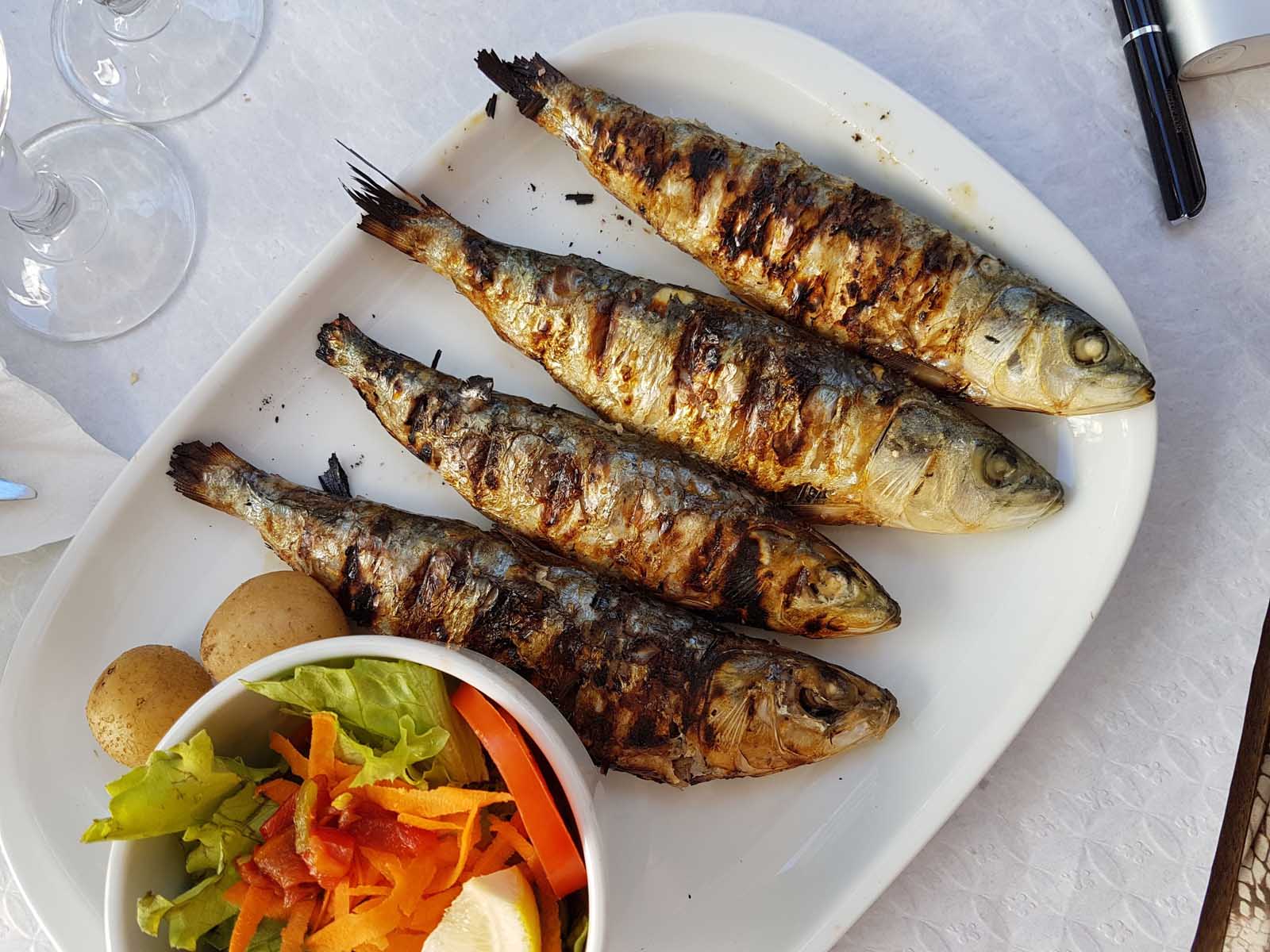
Freshly grilled sardines are a juicy, staple dish in Portuguese gastronomy. Historically, grilled sardines were a dish of the lower classes, thanks to their low cost and high nutrient level. Even now, the dish is probably the most affordable seafood dish you could try in Portugal. Grilled sardines make a great snack or light lunch.
Sardines have a strong flavor and are often salted before grilling. The secret to the perfect grilled sardines is the grilling style. Most recipes ensure that sardines are slow-grilled to maintain as much moisture and flavor as possible.
The best time of year to sample freshly grilled sardines is between June and October when the fishing season is at its peak. Of course, you can also find canned sardines all over Portugal and in most countries abroad, so don’t despair if you are looking for an easier option. While less common, you can eat sardines raw. There are lots of ways to sample Portugal’s most famous fish.
4. Piri Piri chicken
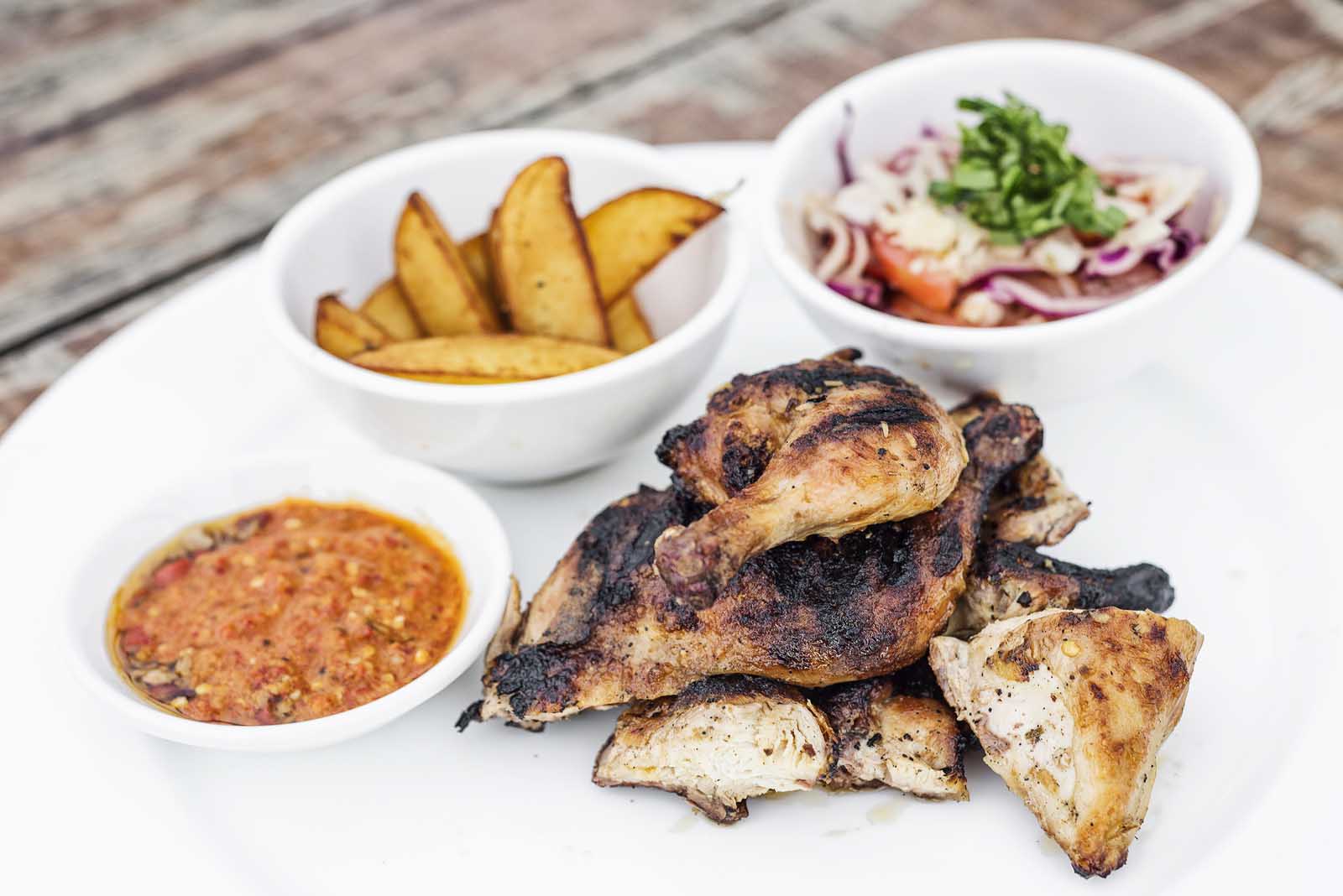
Who hasn’t heard of Piri Piri chicken? The super chain restaurant Nandos has spread the dish across the globe, and it is now a household name, not just Portugal’s national dish. It is easily one of the most famous Portuguese dishes.
The famous dish is unique because of the sauce that it coats its chicken in. It’s a little spicy and sweet, typically made from lemon, pepper, garlic, bay leaves, vinegar, chili, and (of course) olive oil. Each chef has their own adaptation of Piri Piri sauce, and it is fun to sample different people’s recipes.
Piri Piri chicken wasn’t just created in Portugal, though. Portuguese colonizers ‘found’ the chili pepper while abroad in newly founded Portuguese colonies, transporting the peppers back home with the rest of their plunder. The chili peppers would become a vital part of Piri Piri sauce – giving it that characteristic spicy kick.
Piri Piri chicken is usually served alongside French fries and a light salad. Piri Piri chicken is probably the easiest to find out of all our Portuguese foods in this guide. You should find a restaurant selling Piri Piri chicken whether you are in Portugal or not. If you like to cook at home it is pretty easy to make especially with this recipe.
5. Peixinhos da Horta
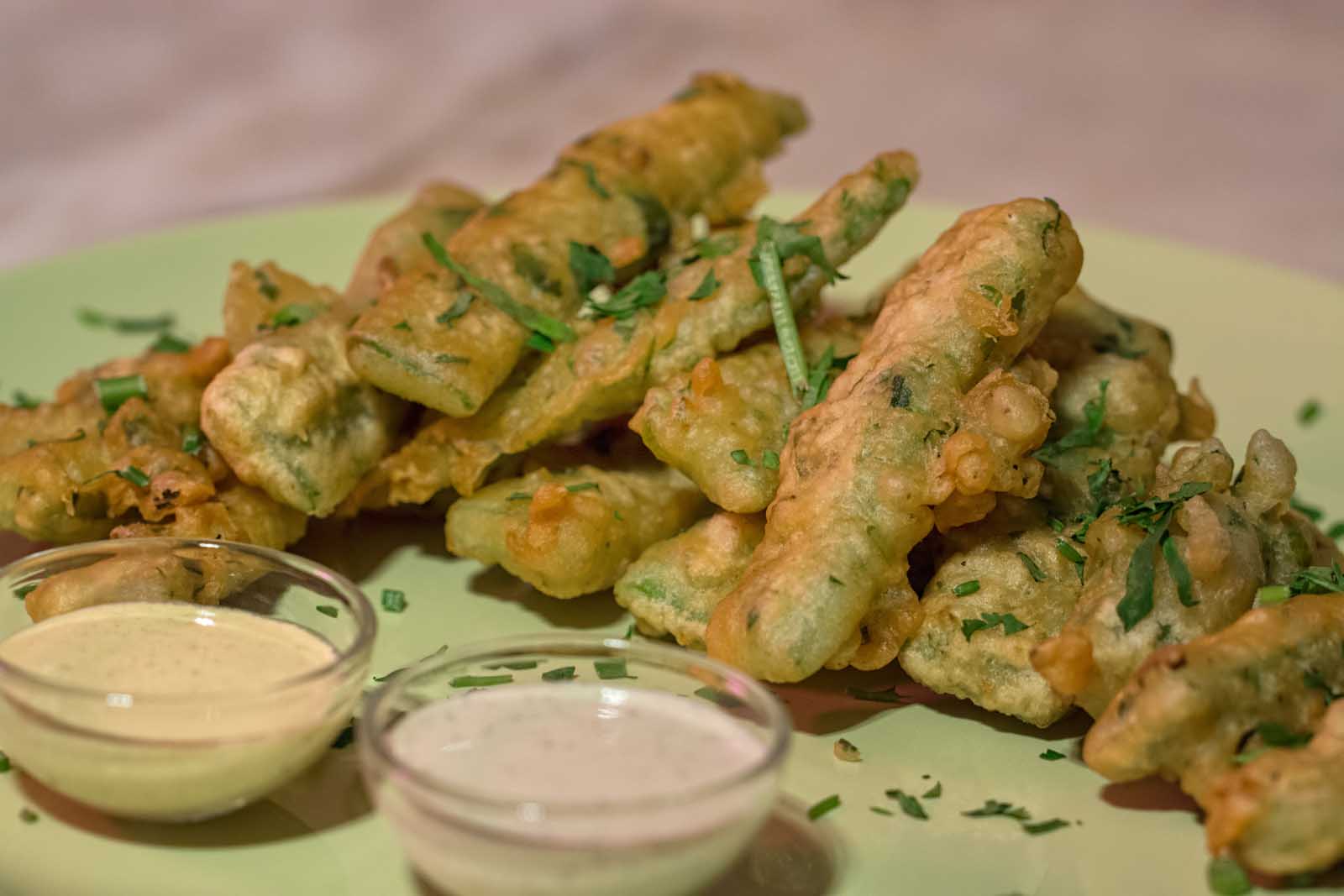
Get ready for one of the Portuguese cuisine’s most bizarre (but delicious) appetizers. Peixinhos da Horta is fried green beans coated in a light batter and typically served for lunch. Peixinhos da Horta translates as ‘little fishes from the garden’, and the dish was initially prepared on Portuguese ships to prevent vegetables from going bad.
The process is simple: boiled green beans are coated in a batter and deep fried in olive oil. The result is a crispy coating on a soft green bean, creating a moreish snack that is the perfect accompaniment for a sociable meal.
Peixinhos da Horta is one of the easiest dishes to prepare at home, so definitely give this dish a go if you are a bit daunted by tackling Portuguese cuisine. The food is also fantastic to sample in local Portuguese restaurants if you get the chance. Try peixinhos da horta as a side or appetizer.
6. Olive Oil
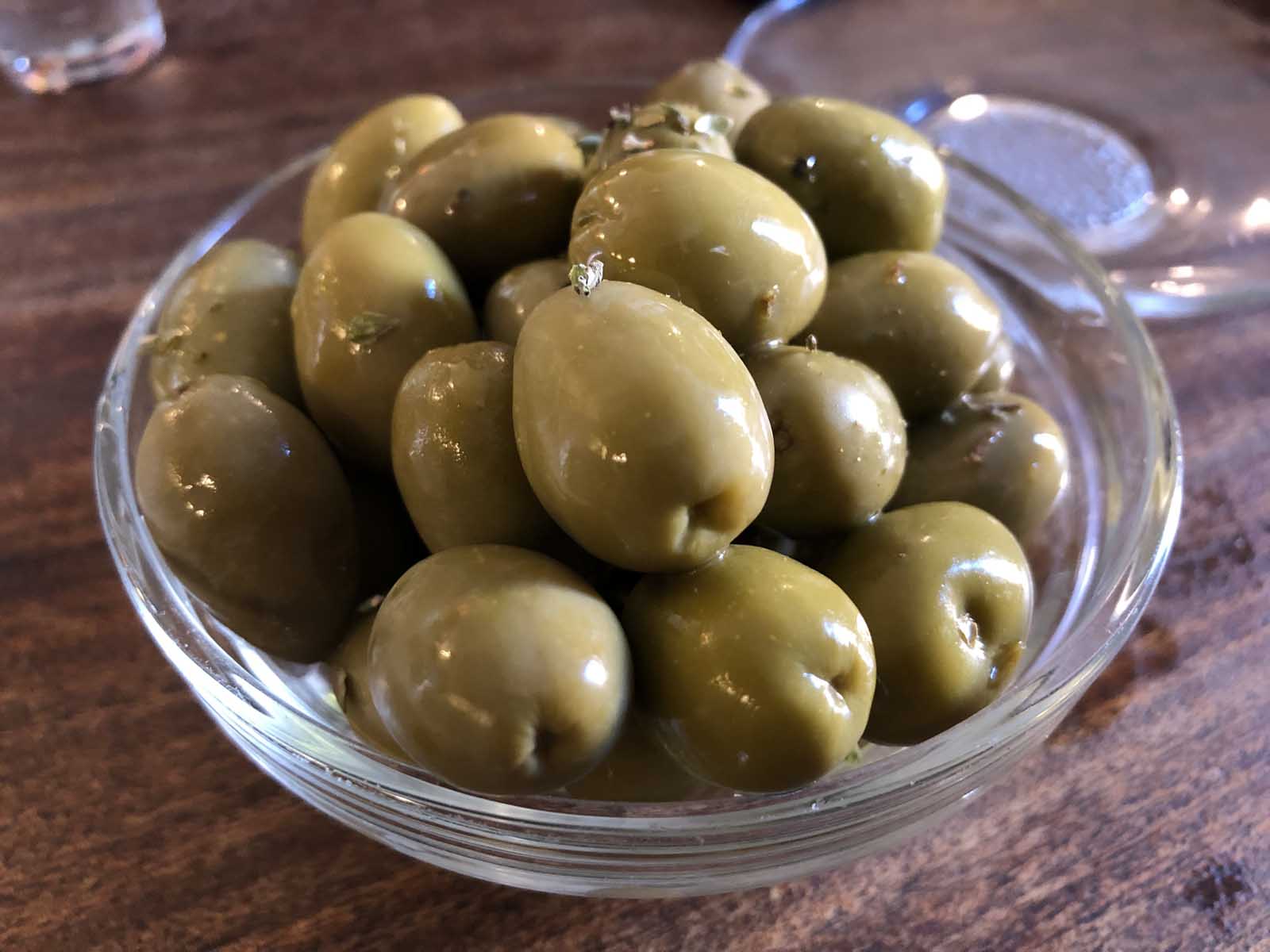
Olive oil isn’t really a Portuguese food in itself. However, it is so carefully manufactured and important in Portuguese foods that we are giving it a section in its own right. It is also a vital ingredient in many Portuguese dishes, so where better to start than with one of the foundation blocks of Portuguese cuisine?
Portugal is one of the largest olive oil producers in the world. Its olive oils are famed for their pungent, often almondy flavor and are typically a deep greenish-yellow in color. The most commonly used olive are Galician olives, which are highly valued for their ancient olive trees. The olive groves in Portugal aren’t just fantastic for creating delicious products. They are also a symbol of natural history and generations of farming culture.
Oil production is a long process. Olives are first grown, then harvested between November and January. The olives are then washed and pressed before being heated to extract and separate the oil.
While olive oil manufacturing mainly occurs around the center of Portugal, some farms also stretch into Southern Portugal. If you want to experience Portuguese oil production, we recommend visiting an area like Sintra, just outside the major city of Lisbon.
7. Arroz de Pato
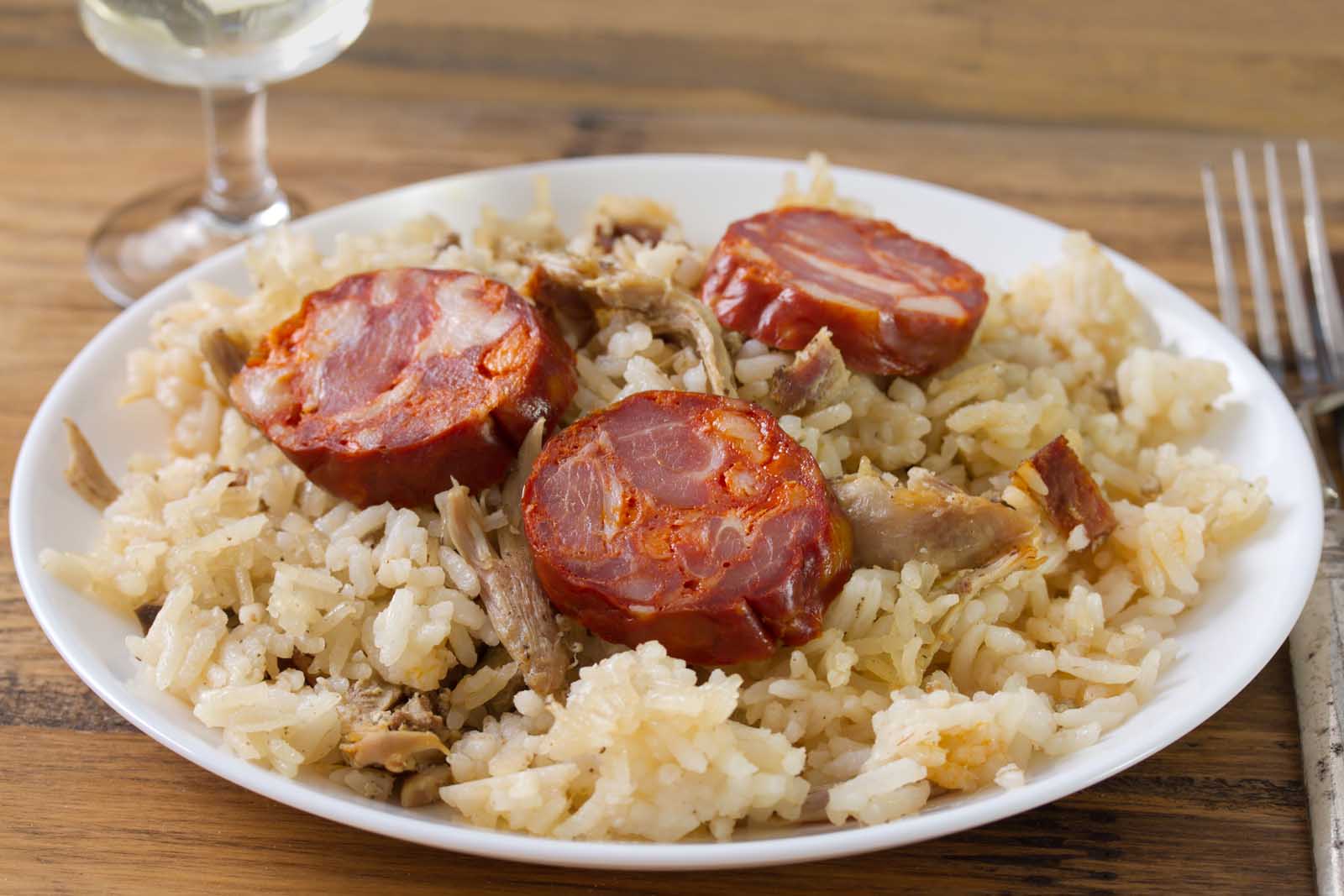
Arroz de pato is one of the most typical Portuguese dishes. The dish’s name translates literally as ‘duck rice’, and it consists of precisely that. The rice is flavored with garlic, bay leaves wine, and plenty of sliced chorizo. The dish packs an intense, flavorsome punch.
Arroz de pato uses rice prepared similarly to risotto, sauteed with onions and fat to slowly fill it with as much flavor as possible. There is generally a preference for wild duck where possible too, which is less fatty and better known for a stronger flavor. Chorizo is usually sliced and spread decoratively across the top of the dish as a final touch.
The dish is hearty and filling – perfect for large family meals and gatherings. You’ll find it at many restaurants since it is one of the country’s leading rice dishes. However, it is equally easy to replicate at home and is an excellent proper meal.
8. Picanha
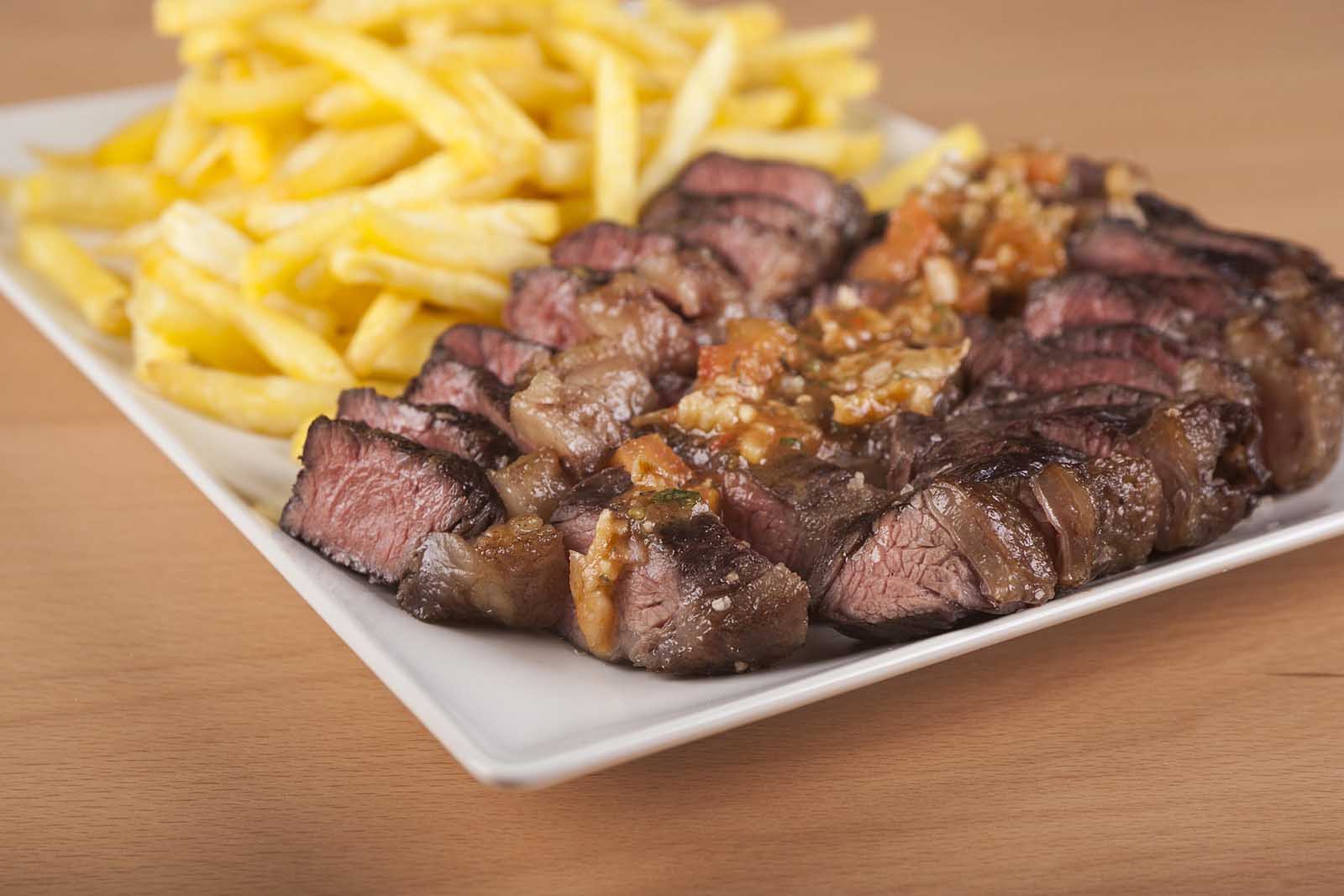
Picanha is a popular beef cut cooked traditionally over a Brazilian barbeque. A Brazilian barbeque, you may be wondering, why Brazilian? Brazil is one of the former Portuguese colonies, and Portugal adopted the dish when its armies arrived there. While still massively popular in Brazil, Picanha is now also hugely popular in Portugal. So popular, in fact, that there is now a set Portuguese recipe – the traditional Brazilian recipe is still used.
The cut itself is rare and is often coined the top sirloin cap. Since most butchers around the world usually divide this section of meat into different cuts (such as the loin or rump), it is quite an experience sampling this cut. The cut is very fatty and tender since there is a layer of fat under the steak. These qualities are coupled with a rich flavor when cooked on Brazilian barbeque.
9. Bacalhau
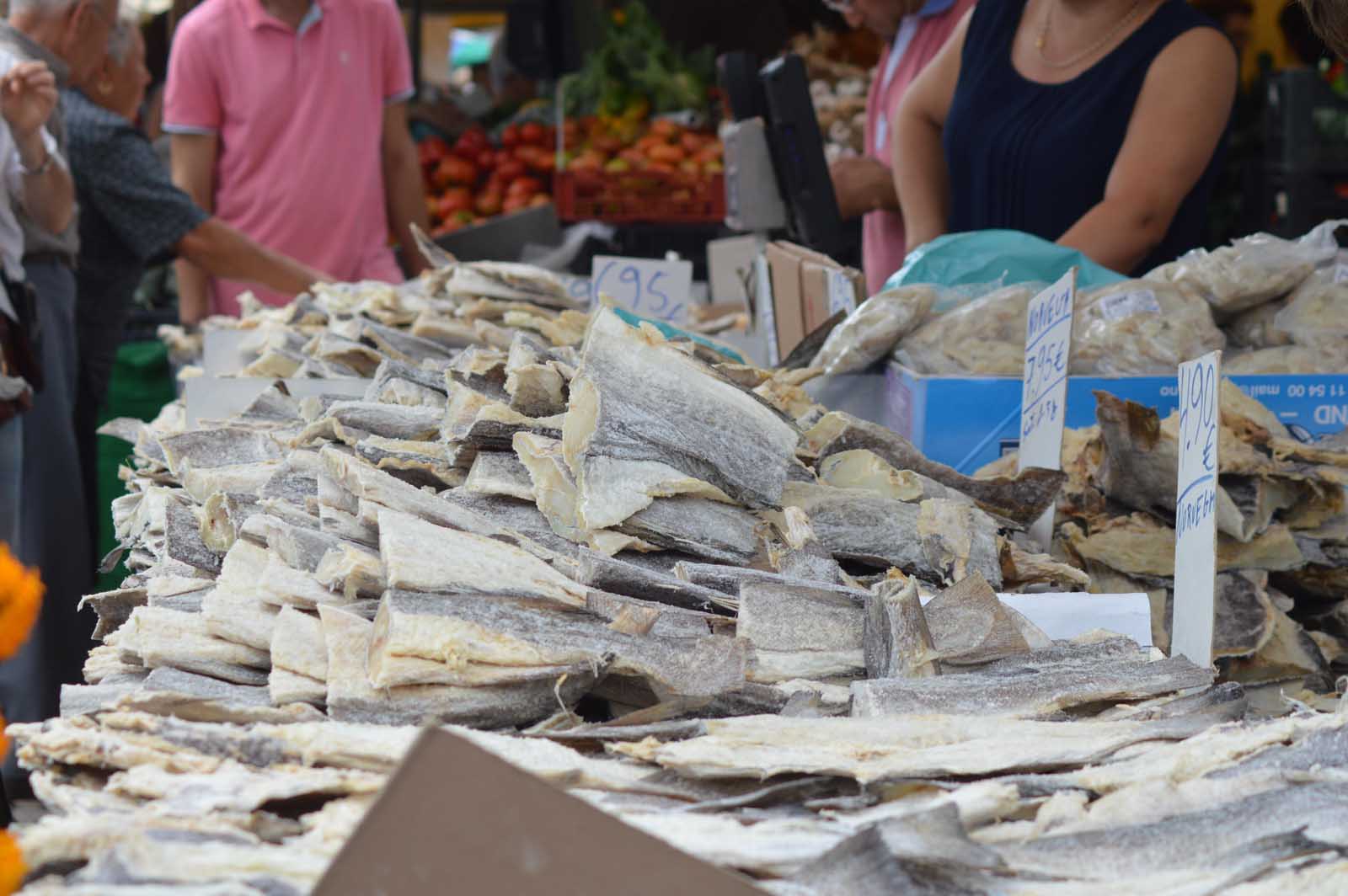
Portuguese love seafood: it is no secret. And if you want to try another national dish of Portugal, add bacalhau to your list of seafood dishes to try. Bacalhau means cod in Portuguese, and a bacalhau dish contains dried and salted cod. The taste is unique, and despite being salted, remains mild tasting and quite sweet.
Surprisingly given the amount of salt, it is also healthy Portuguese food. So, if you are looking for Portuguese food healthy enough to enjoy regularly, bacalhau is an excellent option. Bacalhau is rich in omega oils, high in protein, and very low in fat.
Historically, bacalhau was a great alternative to fresh fish. When fishermen couldn’t fish in bad weather or when families needed to save money, bacalhau had a longer shelf life. Now, you can find Bacalhau at most traditional Portuguese restaurants, and it is a must-try when visiting Portugal.
10. Caldo Verde
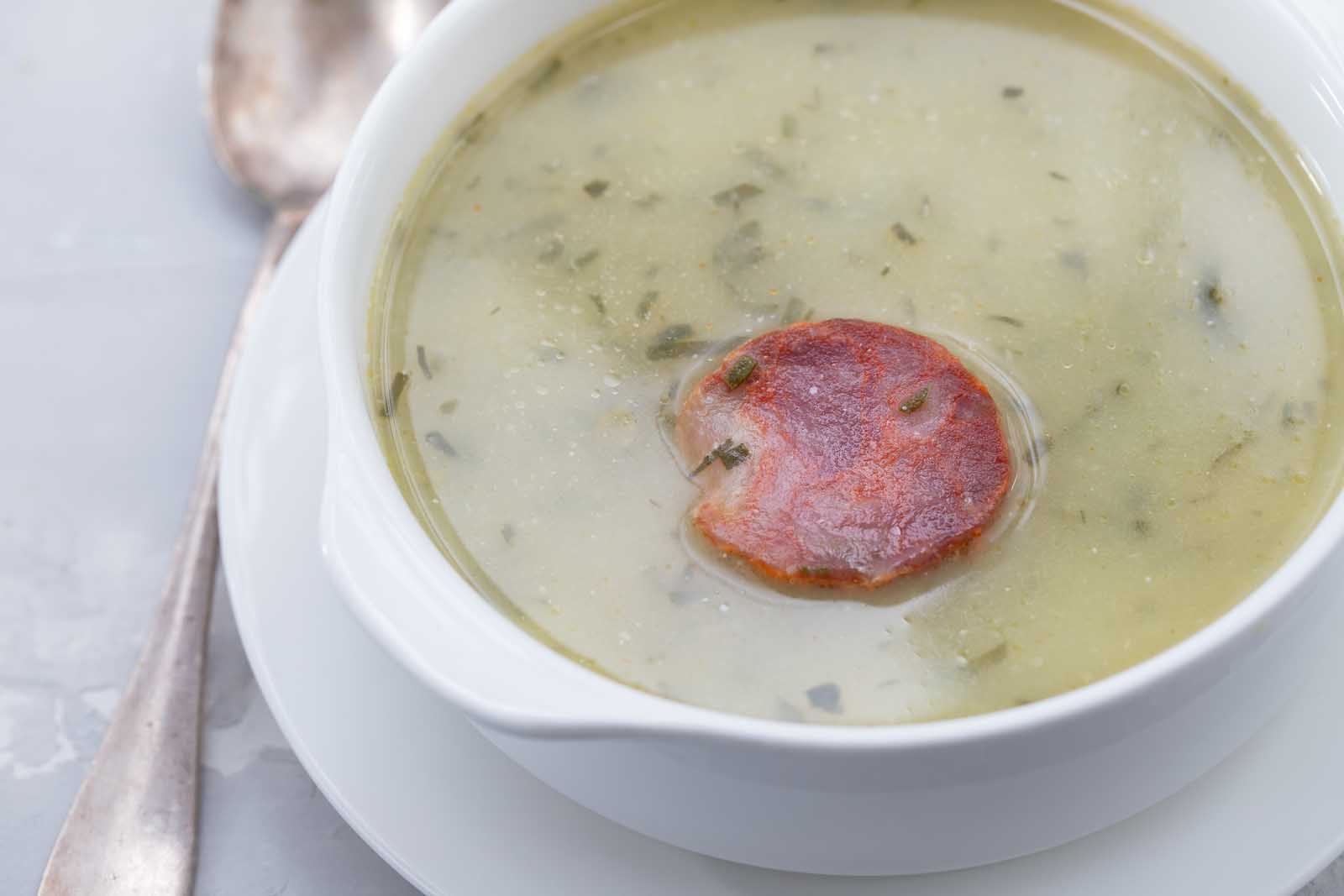
Are you looking for a Portuguese dish on a cold day? Caldo Verde is a warming and extremely tasty soup. The main ingredient is shredded cabbage, although you’ll usually find potatoes, olive oil, onion, and garlic in there as well – seasoned with a little bit of salt and pepper. Caldo Verde is a green color and is occasionally decorated with slices of chorizo as a garnish.
Caldo Verde originates from Northern Portugal in the Minho region. However, now you’ll find it across the country. The soup is also straightforward to make at home and is light enough for a summer brunch yet hearty enough for a perfect winter snack. Each recipe varies, and the soup has been adapted as it spreads through different regions.
11. Bitoque
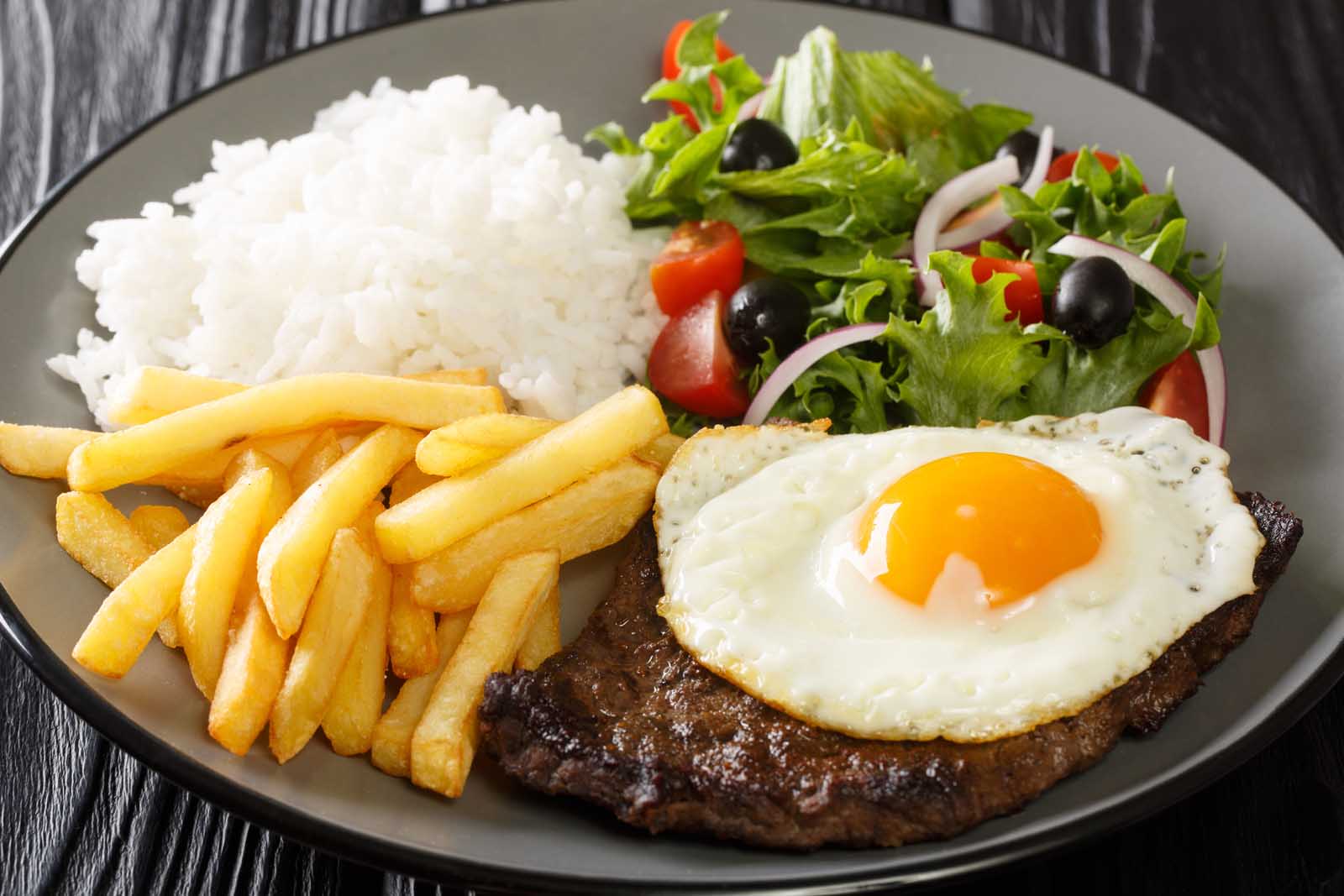
Bitoque is a hearty Portuguese meal. It always includes a lean steak – be it pork or beef. It has a specific presentation and is served with a fried egg on top and a side of fries. It is somewhat of a farmer’s meal and is a basic but classic dish in Portugal.
The dish may be simple, but it is cooked very precisely. The steak is seared in a pan with butter – giving it a tender, distinctive taste and texture. Bitoque is a typical lunch meal across the country and can be found at many local restaurants. Diners typically enjoy bitoque with tomato sauce or mustard.
12. Francesinha
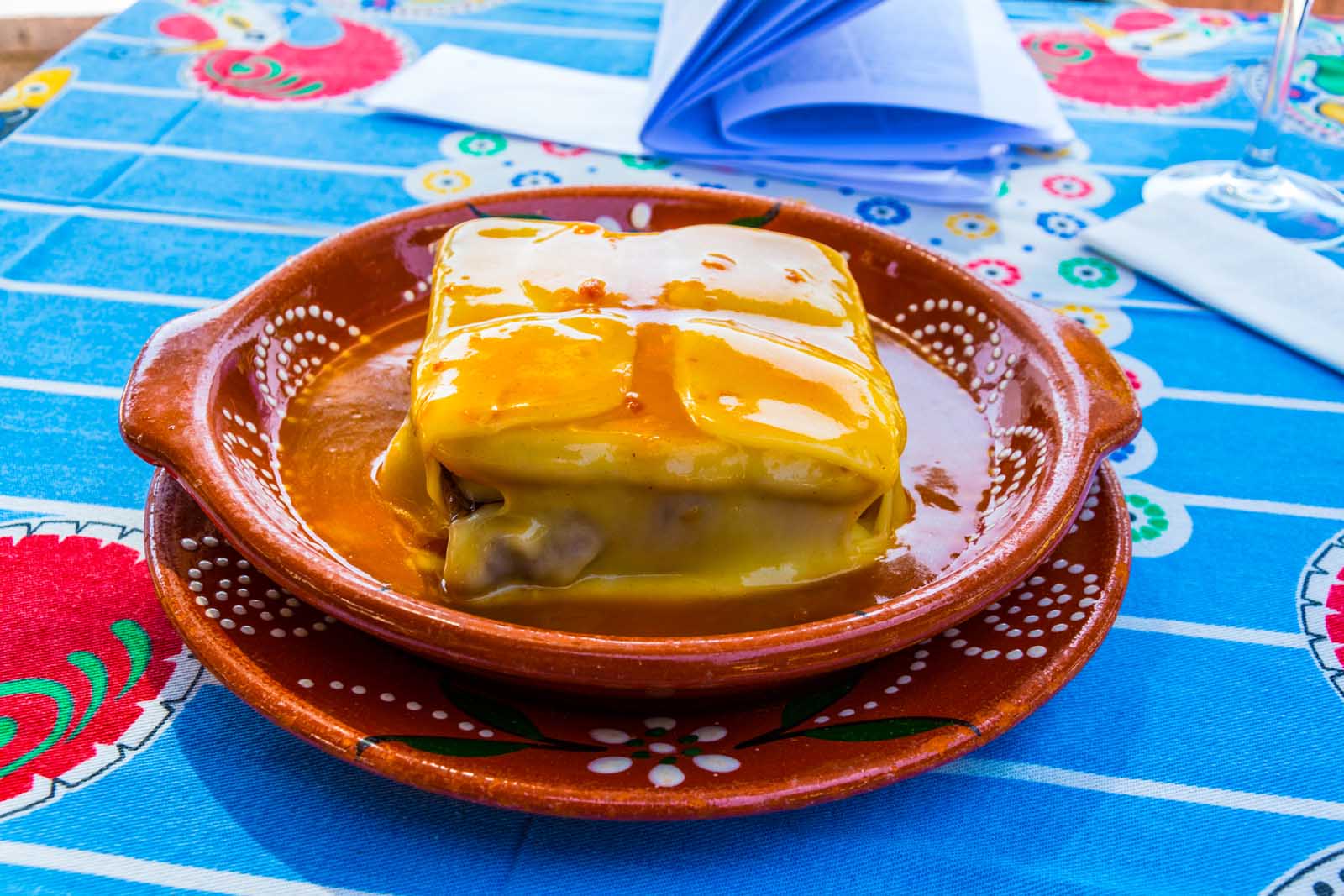
Francesinha is a legendary Portuguese sandwich. The culinary masterpiece is a multi-layer sandwich smothered in melted cheese and packed with different meats. If you want a filling sandwich, Francesinha will exceed all expectations.
Francesinha includes sausage, ham, and steak, packed with cheese between slices of white bread. Extra melted cheese is added over the sandwich’s top, and a spicy beer-based sauce is drizzled on top. Francesinha is messy but delicious. The sandwich spills out of the bread and is eaten on a plate to make it manageable.
Francesinha is the most famous food from Porto, where it originated, and is called the queen of sandwiches by many. It was inspired by the French dish Croque Monsieur and is relatively new to the Portuguese gastronomy scene, created in the 1950s by Daniel Silva. You can recreate the dish at home but try it in Porto for the ultimate experience.
13. Bolinhos de Bacalhau
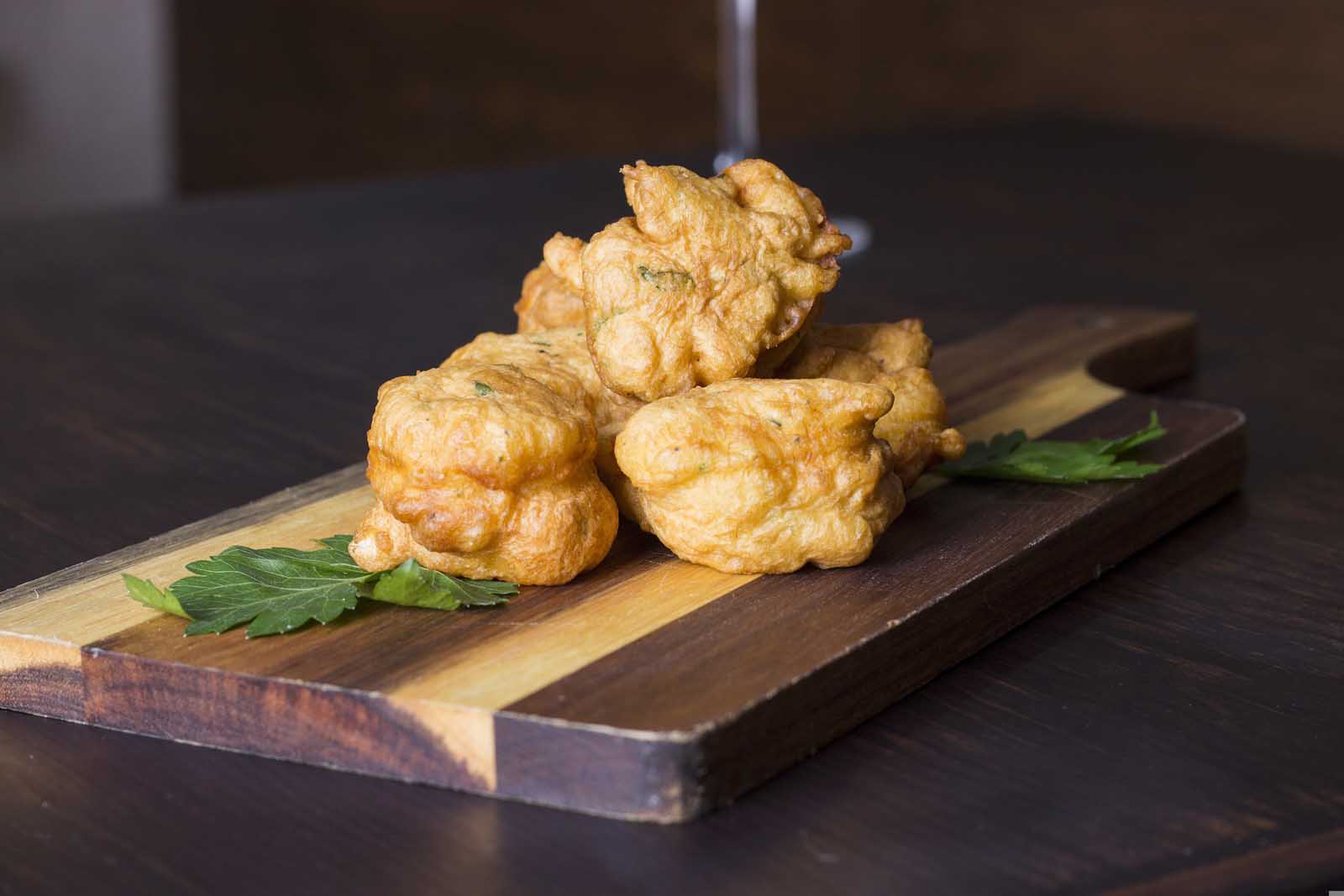
Remember bacalhau, that tasty, salted cod? Well, bolinhos de bacalhau are a tasty bacalhau dish variation. Bolinhos de bacalhau are tiny, deep-fried balls packed with potatoes, bacalhau, eggs, parsley, and onion. They are usually served in high quantities, as they are bite-sized shapes designed to be snacks or appetizers for the main meal.
The preparation is easy, and bacalhau is just mixed in with mashed potato and the other ingredients. The mixture is then shaped into a torpedo ball and deep fried until golden brown. Bolinhos de bacalhau is a quick, easy dish to cook – the perfect Portuguese food for recreating at home. They are best enjoyed freshly cooked, as the texture is crunchy on the outside and soft and warm on the inside.
You’ll find the dish across Portugal at all times of the year. However, they are also extremely popular as festive sides or appetizers at Christmas.
14. Port Wine
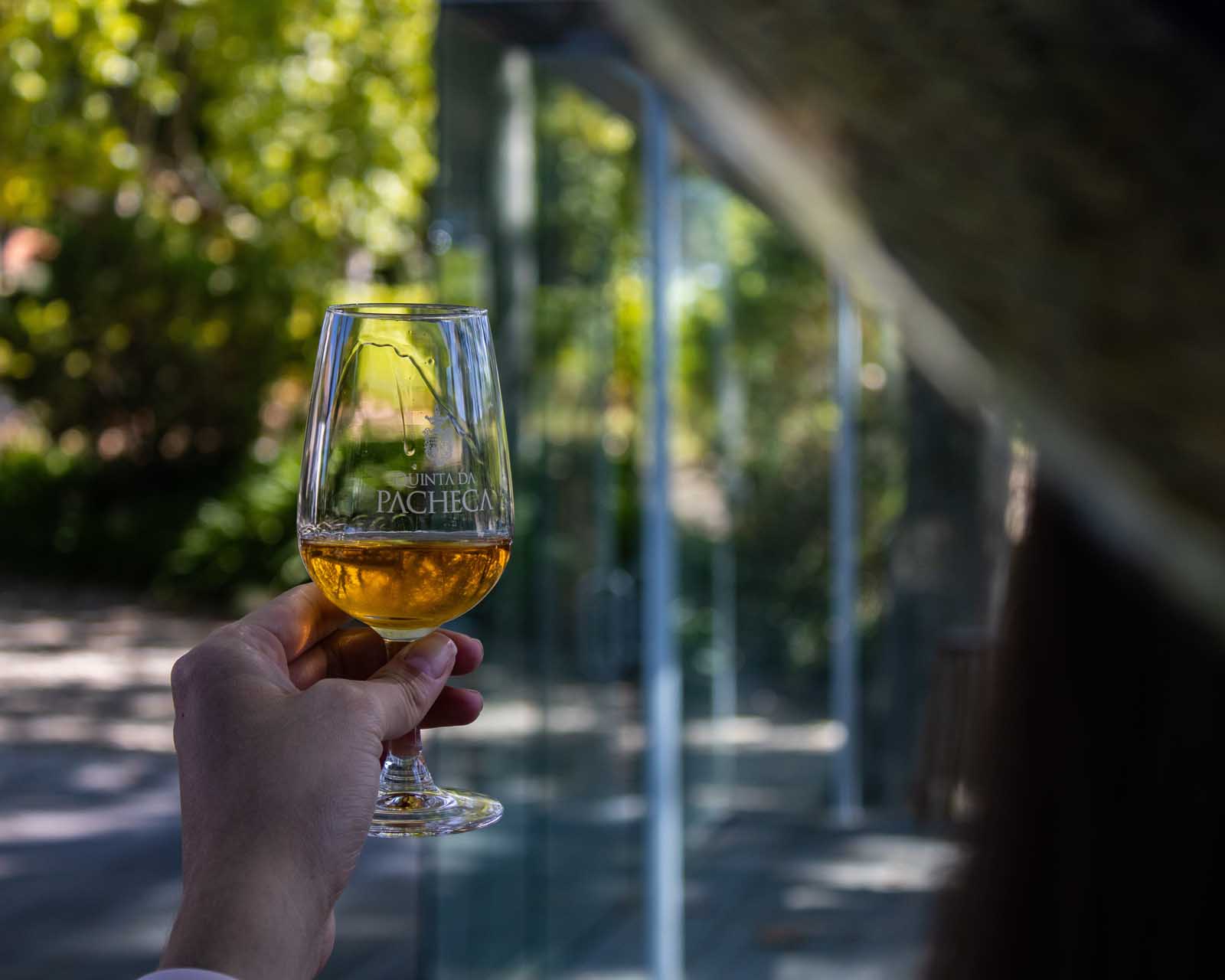
Port wine might not be a dish, but it is the most traditional Portuguese drink (narrowly beating Ginja, which is best tasted in Obidos). And for that reason, we couldn’t leave it out of this guide. Port wine was actually created to help it maintain its quality during long trips. In the 17th century, merchants began adding brandy to Portuguese wine to fortify it and stop it from spoiling during transit. The taste became popular, and now you can find port wine worldwide.
Port wine is a tasty part of Portuguese cuisine, and the drink is known for its super sweet and intense taste. It has a much higher alcohol content and is often considered a dessert wine – enjoyed in a smaller glass than wine.
Port wine can be enjoyed worldwide. However, it is best enjoyed at an atmospheric Portuguese restaurant. You should definitely treat yourself to a taste of port wine with your meal. Alternatively, visit the Douro Valley, the major port wine region in Portugal.
15. Linguica

Linguica is a classic spicy Portuguese food. The dish is a type of sausage known for its intense flavor. Linguica typically contains garlic, paprika, and chili – usually mixed with pork meat. The sausages can be enjoyed in many forms, including as a standalone dish and ingredient in other dishes like Caldo Verde. Linguica is tasty Portuguese food, spicy and packed with flavor.
Linguica is also sometimes called Portuguese smoked sausage. It gets this name from how it is prepared, as typically linguica is cooked with smoke to give it an extra unique flavor. If you try linguica at a restaurant, it will most likely be served smoked, but it is up to you if you wish to try to smoke it at home. While not a necessity, it certainly gives it a unique flavor.
16. Pão de Deus
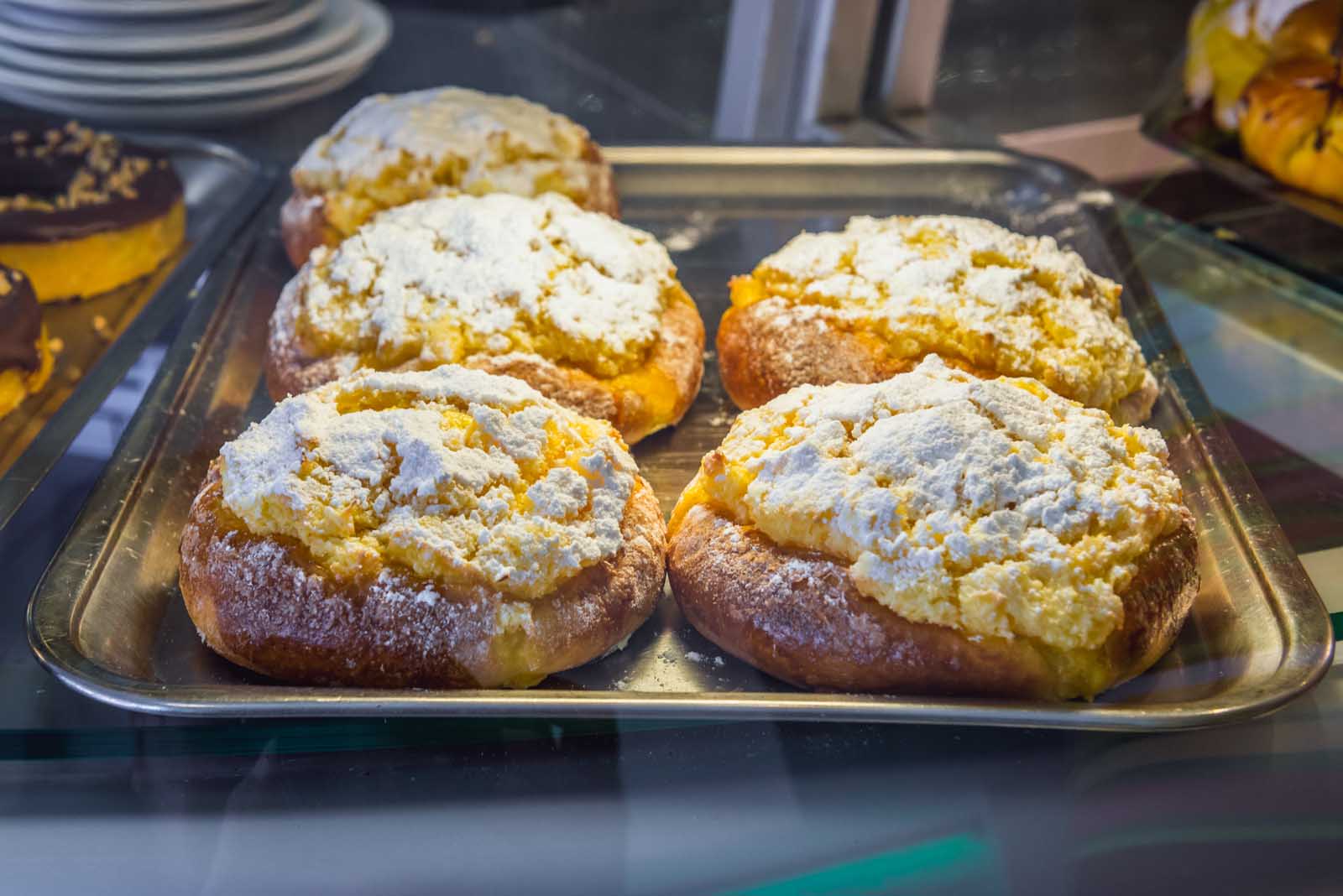
We’ve covered a lot of dishes for lunch and dinner so far, but what about breakfast? Well, pão de Deus is a popular breakfast dish. Pão de Deus is a Portuguese bread roll with a soft, fluffy interior. The rolls are typically shaped into single serving circles, perfect for enjoying a quick morning snack.
Pão de Deus translates as ‘God’s bread’ and was initially baked in convents centuries ago. The sweet, brioche-like bread is usually served topped with coconut and dusted with powdered sugar – the ideal sweet treat to start your morning right.
Sadly, pão de Deus is rare to find outside of Portugal. However, visiting Portugal, you’ll find pão de Deus all over the country, especially in bakeries and cafes. We suggest ordering a coffee with your bread roll for the best breakfast combination.
17. Serra da Estrela Cheese
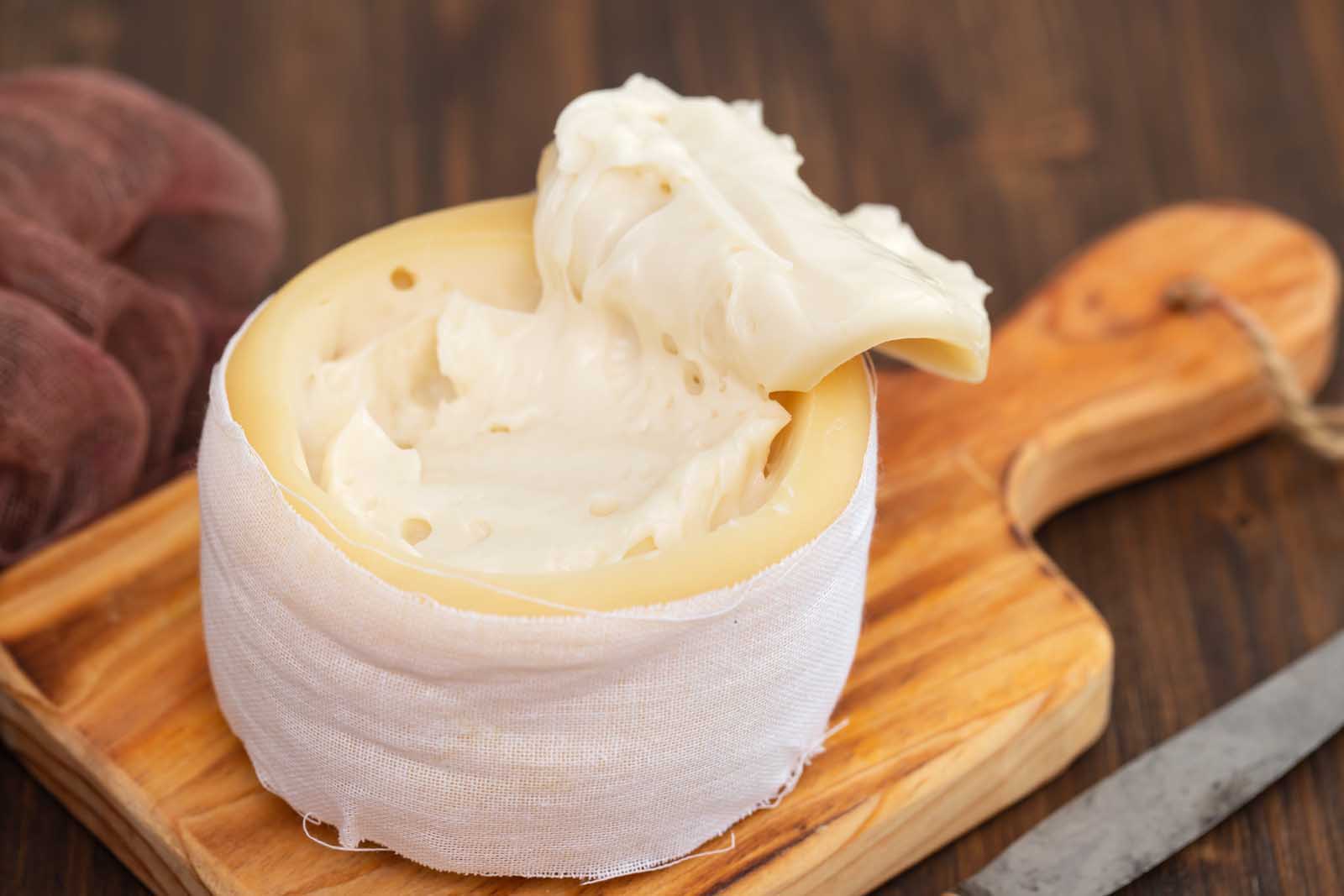
We’ll start by saying that all Portuguese cheeses are delicious. However, Serra da Estrela cheese is the tastiest. This Portuguese cheese comes from the mountains of Portugal’s Serra da Estrela region. It is produced especially from the milk of Bordaleira sheep. Serra da Estrela cheese is a distinctive yellow color and has been using the same recipe since the 16th century. Cheese production is not just a culinary process but also part of Portugal’s cultural heritage.
Serra da Estrela cheese contains a special ingredient – the Cardoon plant. Cardoon is a wild thistle and leaves a floral, tangy undertone to the cheese. This is added in the early stages, with oil rubbed over the rind once the cheese has solidified.
You can sample Serra da Estrela worldwide and definitely all around Portugal. However, to experience its production, it is best to head to Serra da Estrela itself. The closest airports are Viseu Airport and Porto Airport.
18. Bola de Berlim

Ready for another sweet treat? Bola de berlin are sweet-fried doughnuts. Unlike most doughnuts, though, they don’t have a hole in the center or a stuffed filling. Instead, bola de berlin has a creme filling between two doughnut layers – like a doughnut sandwich.
Bola de berlin is actually a twist on German doughnuts, using Portuguese creme instead of jam as a filling. It is rumored that the doughnuts became adopted in Portuguese cuisine after German Jewish families started relocating to find refuge in Portugal in the 1930s.
You can find bola de berlin in most bakeries and cafes, and the sweet treat can be enjoyed anytime.
19. Cebolada
Cebolada is a flavorsome dish that is essentially an onion stew. Cebolada is a versatile dish to cook, and you’ll commonly find it served alongside fish, potatoes, or a bread bun. The dish consists of tomatoes, red bell peppers, parsley, garlic, onion, and oil – all sauteed until thickened into a hearty sauce.
Cebolada is a popular restaurant or family meal ideal for catering to large groups of people. Simple but beautifully tasting, Cebolada is a traditional Portuguese dish for you to try.
20. Carne de Porco Alentejana
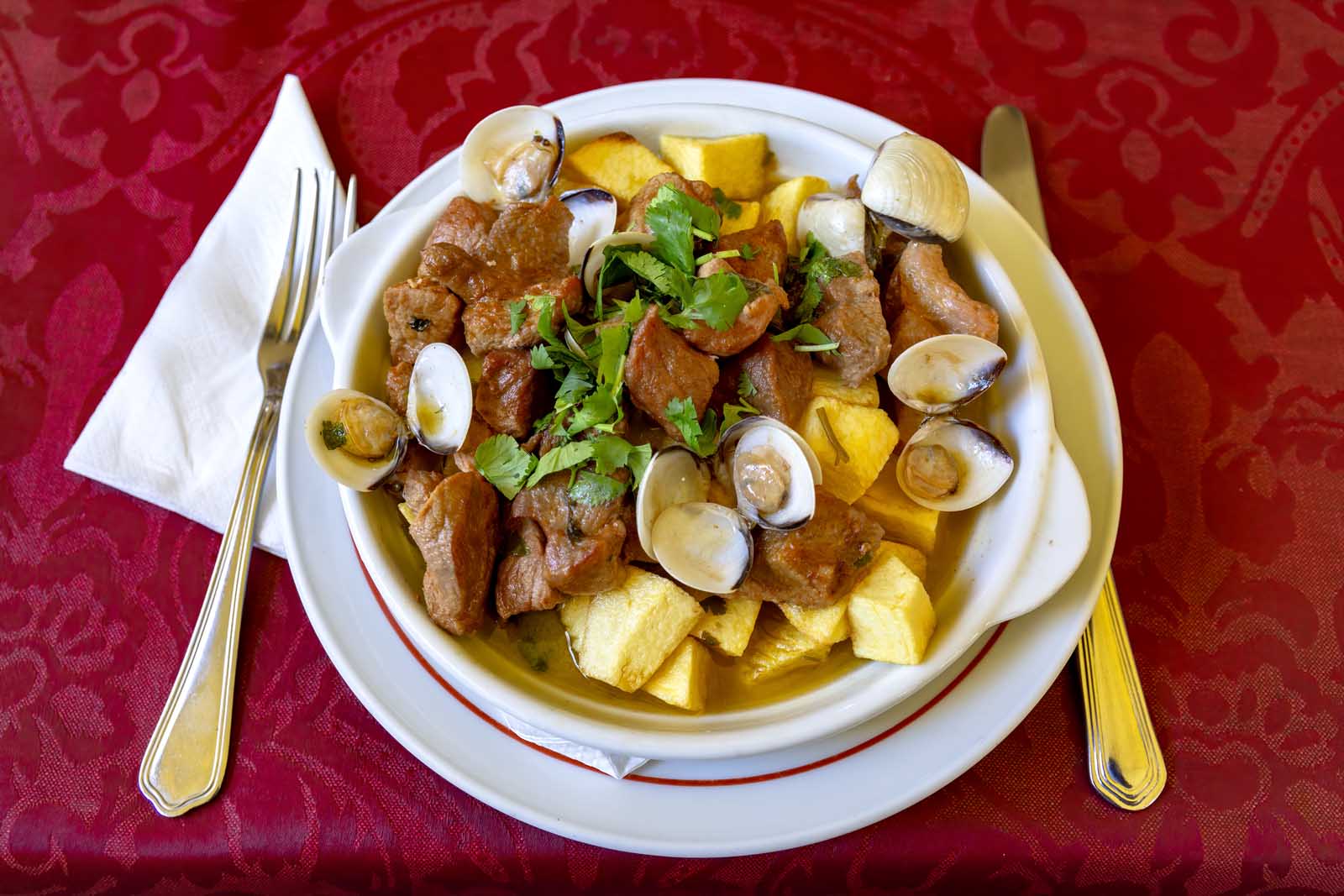
Carne de Porco Alentejana is one of the best Portuguese foods if you want a blend of seafood and meat. The unique dish combines pork and clams in a mix of potatoes and chopped coriander. It is best enjoyed as a hearty meal, usually at an evening meal or gathering.
The name ‘Alentejana’ is a place in Portugal, so you might be led to believe that the dish originated there. This isn’t the case, though; the dish is thought to have originated in the Algarve region. Instead, it was named after Alentejana because of that region’s highly prized black pigs.
Of course, now, the dish is available all over Portugal. If you like seafood and want to try a traditional pork dish as well, it is the perfect Portuguese food to enjoy on an evening. Get the full recipe here at Food From Portugal
21. Ovas
As far as Portuguese foods go, ovas is a particularly adventurous one. The dish is considered a delicacy and is made from fish roe – fish eggs. Fish eggs may sound like a bizarre snack, but the method for preserving fish roe sacks can be traced back to Egyptian times through ancient murals. People have been eating fish eggs worldwide for hundreds of years, and ovas are Portugal’s version of the old recipe.
The eggs typically come from a grey mullet fish, and the sack is boiled before being eaten. You’ll usually see the dish served with potatoes and vegetables, drizzled with oil and vinegar. The egg sack has a very smooth, silky texture, and ovas are a popular dish because of it.
23. Arroz de Marisco
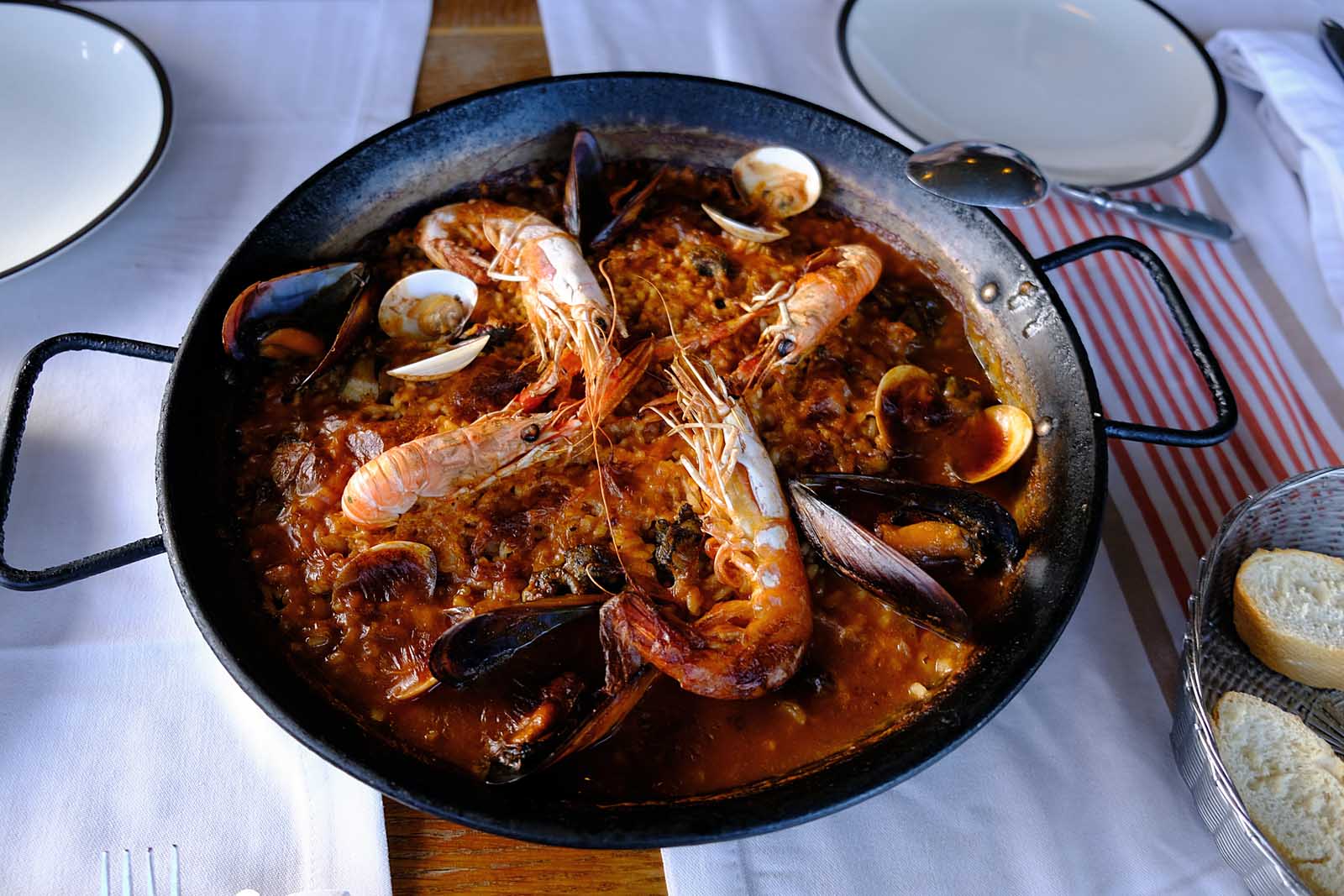
Let’s get back to seafood. Arroz de Marisco is delicious seafood rice, not unlike a Spanish paella. The main difference is that Arroz de Marisco is not reduced, so it stays thick and more like a rice stew. Its ingredients vary a little, but you can usually expect prawns, mussels, clams, and squid. The finishing touches are a sprinkling of herbs and a generous dash of white wine.
Traditionally, you’d find Arroz de Marisco in Portugal’s coastal areas thanks to the abundance of fresh seafood. If you want fresh seafood, trying Arroz de Marisco in these areas is still best. However, you can find the dish inland as well these days, and it is also easy to recreate at home.
22. Feijoada
As we mentioned earlier, Brazil is one of Portugal’s former colonies. Many Brazilian dishes can be found in Portugal today, including feijoada. Feijoada is a traditional stew consisting of black beans, pork, and beef. Historically, feijoada used cheaper cuts of meat, like tongue, ears, feet, and tails, to ensure less wastage and build a budget-friendly meal. This isn’t always the case now.
The stew is moderately salty but not spicy. It gets a lot of natural flavoring from the meats and black beans. In Portugal, the Brazilian recipe is still favored, and you’ll find a little deviation from the original recipe. Feijoada is a great warming meal, especially on a cold winter day.
24. Caldeirada de Peixe
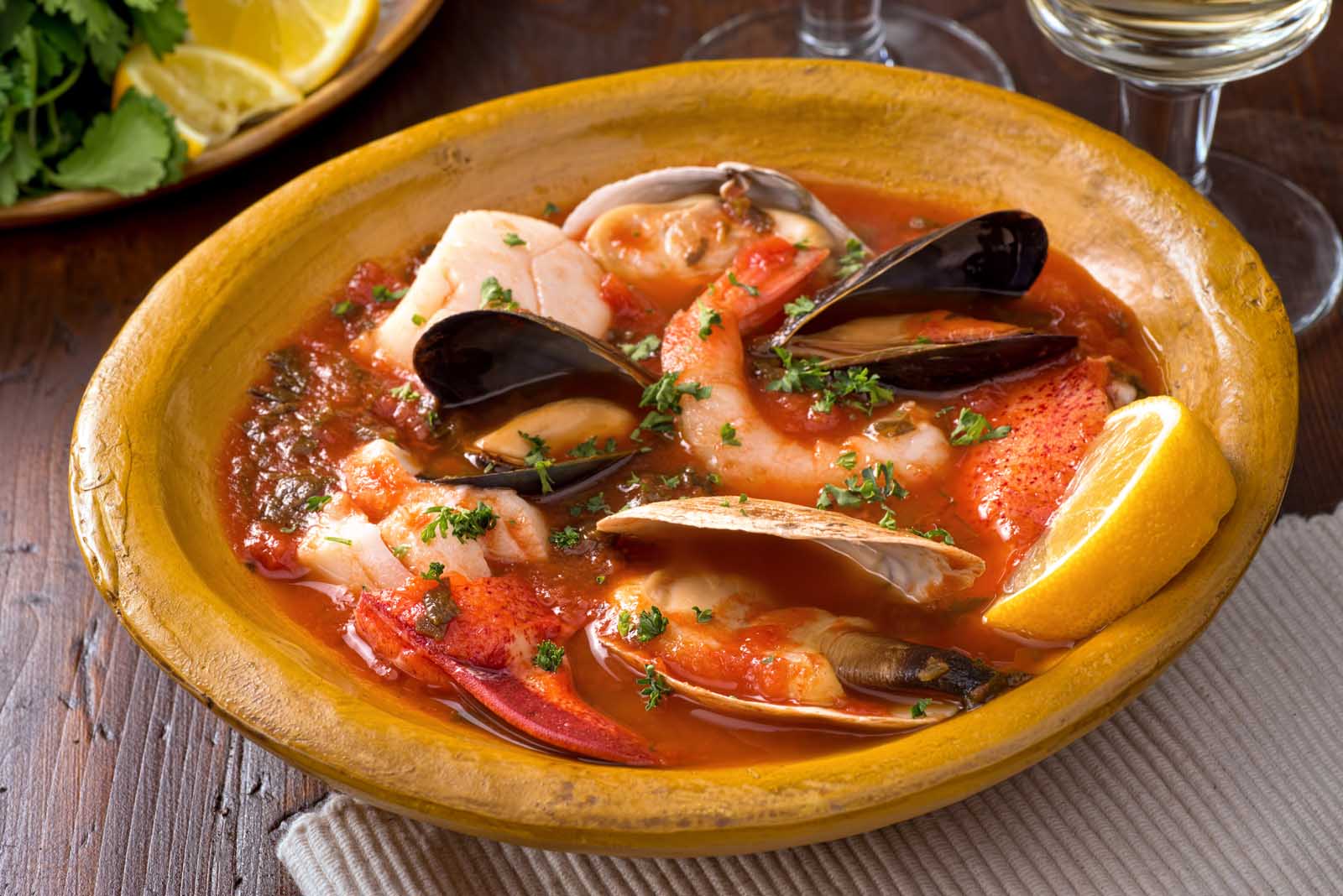
Caldeirada de Peixe is another hearty dish, ideal for a cold day. Caldeirada de Peixe is a fish and potato stew flavored with saffron and sometimes containing extra seafood like prawns, squid, and mussels. The beauty of Caldeirada de Peixe is that it uses whatever seafood the fishermen catch, which historically made it a reliable meal for the lower classes.
In modern recipe adaptations, you’ll find loads of extra flavorings. Bay leaves, parsley, and peppercorns are popular additions. You can expect Caldeirada de Peixe to have a strong, memorable taste.
25. Cozido a Portuguesa
Cozido a Portuguesa may look like a mismatched dish. The dish contains an assortment of meat and vegetables prepared as a boiled meal. The cooking style makes Cozido a Portuguesa very healthy, skipping out the oil and deep frying that can make some Portuguese dishes less healthy.
Cozido a Portuguesa typically contains meat like pork ribs, beef, chicken, bacon, and sausage. It is a fantastic dish to use cheaper cuts of meat, like pig’s ears and feet. These meats are boiled together in a large saucepan and seasoned with salt. Vegetables like parsnip, turnip, potato, carrots, and cabbage are also boiled – served alongside the meat on a large plate.
Cozido a Portuguesa is a no-nonsense dish that flexibly uses leftovers to prevent waste. It is believed to have originated from Beira, but it is no longer just prepared in a single area of Portugal.
26. Bifana or Prego
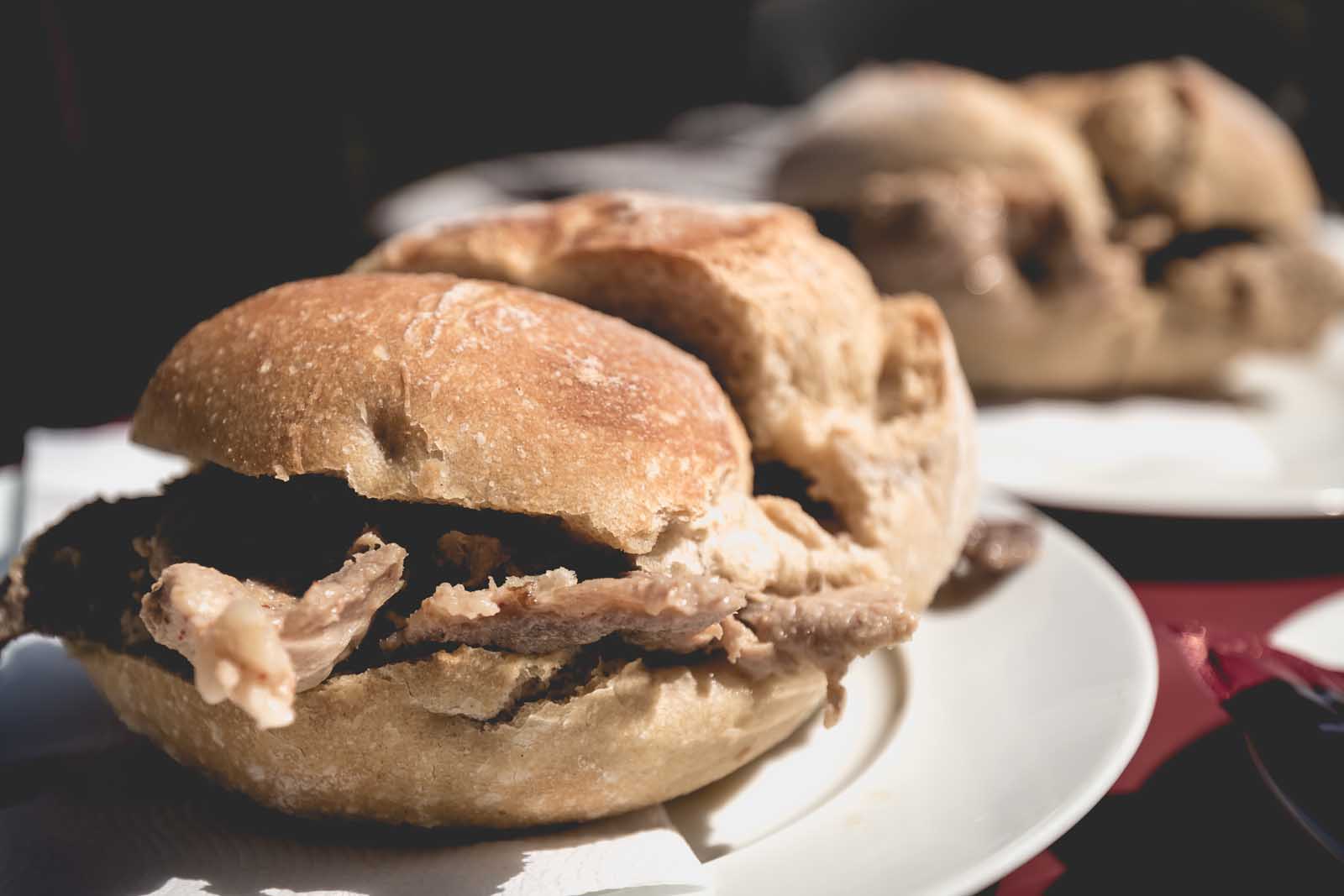
We covered the queen of sandwiches, Francesinha. But if Francesinha is the queen of Portuguese sandwiches, bifana and prego are the princesses. These two sandwiches are some of the best takeaway Portuguese foods and lunchtime snacks.
Unlike Francesinha, these two sandwiches are straightforward with minimal ingredients. Bifana uses pork, while prego uses beef. Both are served on soft, fresh bread, commonly found at cafes or takeaways. Bifana sandwiches marinate the pork in a spicy sauce, while prego sandwiches marinate the beef in a garlic sauce. Which you decide to try is entirely up to you.
Final Thoughts on Portuguese Cuisine
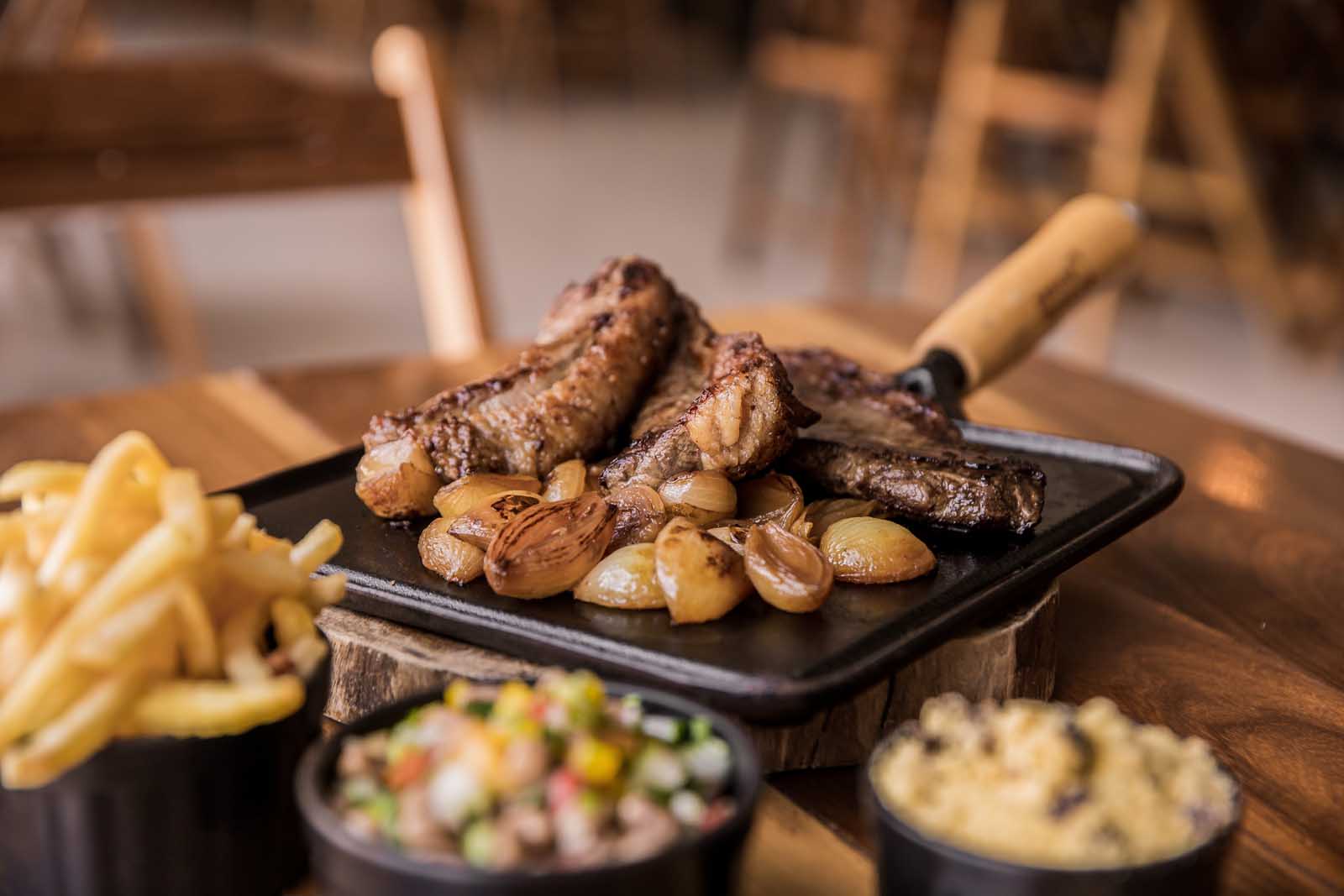
There are so many Portuguese dishes to try. If you are traveling to Portugal, we recommend taking a food tour and hopping around different local restaurants. Don’t be afraid to get off the beaten track. If you are cooking Portuguese food at home, prepare to get experimentative. You could even host a Portuguese tapas night if you are feeling brave.
Either way, Portuguese gastronomy is incredible to explore. Traditional Portuguese cuisine is one of the best in the world, and we hope you try as many of these dishes as possible.
Check Out Great Food From Around Europe
- German Food: 20 Traditional Dishes To Try in Germany or At Home
- Spanish Food: 17 Spanish Dishes to Try in Spain or at Home
- French Food: 24 Traditional Dishes To Try in France or At Home
- Italian Food: 27 Italian Dishes to Try in Italy or at Home
- British Food: 23 Best UK Dishes to Try at Home or Abroad
- 15 Swiss Foods to try in Switzerland or at Home
- 17 Best Things To Do in Guimarães, Portugal in 2024




Hey guys! 😉
I’m Portuguese and loved this list. Well done!
Just want to add one that not everybody loves, but I think is delicious. It is “Arroz de Sarrabulho”, originated from Ponte de Lima, in the north of Portugal, and it is made with blood. 😀 Truly, search for it and go try it!
For sweets I really love Abade de Priscos Pudding, from Braga! 😉 Check it also!
Pedro
My mouth was watering just by looking at the images! Thanks for sharing this! Would definitely visit here if given a chance (even if just for the food)!